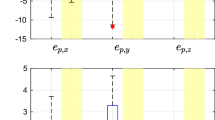Abstract
The aeromechanical analysis of rotorcraft using comprehensive multibody vehicle models is crucially dependent on the ability to accurately compute the model trim settings. Among the various techniques proposed in the literature, the auto-pilot approach, being independent of the complexity of the model, has the potential to solve trim problems efficiently even for the highly detailed aero-servo-elastic vehicle models that are developed using modern finite-element-based multibody analysis codes. Published proportional auto-pilots show to work well in many practical instances. However, their robustness with respect to the flight condition is often poor, so that they must be accurately tuned. In this paper, an auto-pilot based on adaptive non-linear model-predictive control is proposed. The formulation uses a non-linear reference model of the rotorcraft, which is augmented with an adaptive neural element. The adaptive element identifies and corrects the mismatch between reduced and comprehensive models, thereby improving the predictive capabilities of the controller. The methodology is tested on the wind-tunnel trim of a rotor multibody model and compared to an existing implementation of a classical auto-pilot for comprehensive rotorcraft analysis applications. The proposed controller shows improved stability over the conventional approach without the need for calibration.
Similar content being viewed by others
References
Rutkowski, M., Ruzicka, G.C., Ormiston, R.A., Saberi, H., Jung, Y.: Comprehensive aeromechanics analysis of complex rotorcraft using 2GCHAS. J. Am. Helicopter Soc. 40, 3–17 (1995)
Peters, D.A., He, C.J.: Finite state induced flow models. Part II: Three-dimensional rotor disk. J. Aircr. 32, 323–333 (1995)
Bhagwat, M.J., Leishman, J.G.: Stability, consistency and convergence of time marching free-vortex rotor wake algorithms. J. Am. Helicopter Soc. 46, 59–71 (2001)
Bauchau, O.A., Bottasso, C.L., Nikishkov, Y.G.: Modeling rotorcraft dynamics with finite element multibody procedures. Math. Comput. Model. 33, 1113–1137 (2001)
Peters, D.A., Barwey, D.: A general theory of rotorcraft trim. Math. Probl. Eng. 2, 1–34 (1996)
Antos, P., Ambrósio, J.A.C.: A control strategy for vehicle trajectory tracking using multibody models. Multibody Syst. Dyn. 11, 365–394 (2004)
Frezza, R., Beghi, A., Notarstefano, G.: Almost kinematic reducibility of a car model with small lateral slip angle for control design. Paper presented at the IEEE International Symposium on Industrial Electronics, Dubrovnik, Croatia, 20–23 June 2005
Frezza, R., Beghi, A., Saccon, A.: Model predictive control for path following with motorcycles: Application to the development of the pilot model for virtual prototyping. Paper presented at the 43rd IEEE Conference on Decision and Control, Atlantis, Paradise Island, Bahamas, 14–17 December 2004
Meirovitch, L., Tuzcu, I.: Unified theory for the dynamics and control of maneuvering flexible aircraft. AIAA J. 42, 714–727 (2004)
Bottasso, C.L., Chang, C.-S., Croce, A., Leonello, D., Riviello, L.: Adaptive planning and tracking of trajectories for the simulation of maneuvers with multibody models. Comput. Method. Appl. Mech. Eng. 195, 7052–7072 (2006)
Leitner, J., Calise, A., Prasad, J.V.R.: Analysis of adaptive neural networks for helicopter flight control. J. Guid. Control Dyn. 20, 972–979 (1997)
Enns, R., Si, J.: Helicopter trimming and tracking control using direct neural dynamic programming. IEEE Trans. Neural Netw. 14, 929–939 (2003)
Findeisen, R., Imland, L., Allgöwer, F., Foss, B.A.: State and output feedback nonlinear model predictive control: an overview. Eur. J. Control 9, 190–207 (2003)
Jadbabaie, A., Yu, J., Hauser, J.: Unconstrained receding-horizon control of nonlinear systems. IEEE Trans. Autom. Control 46, 776–783 (2001)
Betts, J.T.: Practical Methods for Optimal Control using Non-Linear Programming. SIAM, Philadelphia (2001)
Barclay, A., Gill, P.E., Rosen, J.B.: SQP methods and their application to numerical optimal control. Report NA 97–3, Department of Mathematics, University of California, San Diego (1997)
Bauchau, O.A., Bottasso, C.L., Trainelli, L.: Robust integration schemes for flexible multibody systems. Comput. Method. Appl. Mech. Eng. 192, 395–420 (2003)
Narendra, K.S., Parthasarathy, K.: Identification and control of dynamical systems using neural networks. IEEE Trans. Neural Netw. 1, 4–27 (1990)
Prouty, R.W.: Helicopter Performance, Stability, and Control. Krieger, Malabar (1990)
Johnson, W.: Helicopter Theory. Dover, New York (1994)
Hornik, K., Stinchombe, M., White, H.: Multi-layer feed-forward networks are universal approximators. Neural Netw. 2, 359–366 (1989)
Fausett, L.: Fundamentals of Neural Networks. Prentice Hall, New York (1994)
Leishman, J.G.: Principles of Helicopter Aerodynamics. Cambridge University Press, Cambridge (2000)
Author information
Authors and Affiliations
Corresponding author
Additional information
Commemorative Contribution.
Rights and permissions
About this article
Cite this article
Bottasso, C.L., Riviello, L. Trim of rotorcraft multibody models using a neural-augmented model-predictive auto-pilot. Multibody Syst Dyn 18, 299–321 (2007). https://doi.org/10.1007/s11044-007-9095-x
Received:
Accepted:
Published:
Issue Date:
DOI: https://doi.org/10.1007/s11044-007-9095-x



